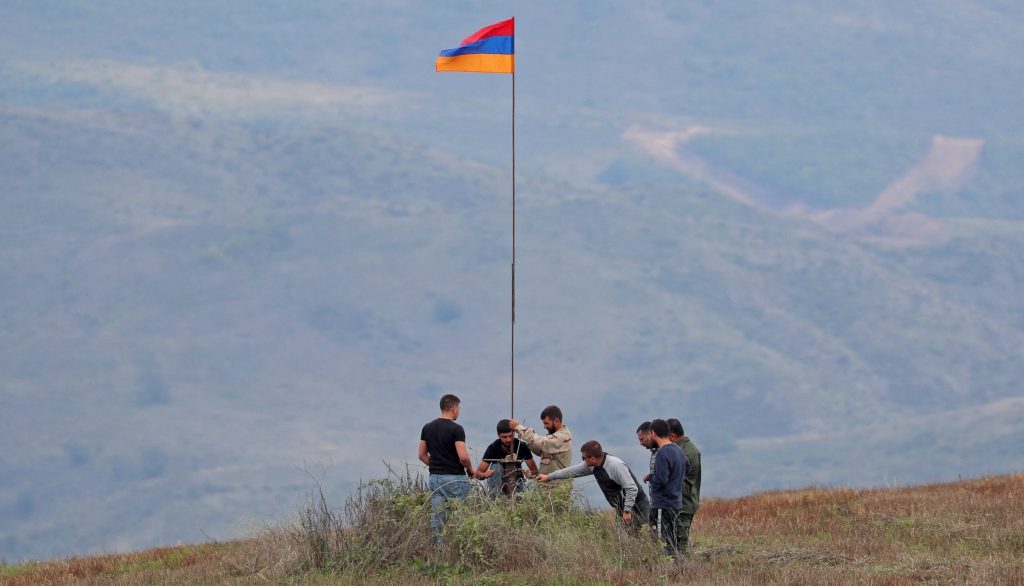In two previous articles we have illustrated, albeit briefly, the rich history of the town. ArmenianToday it is largely exiled throughout the world and to a small extent concentrated in tiny portions of the Caucasus (including the Republic of Armenia) that represent only a shadow of the vast empire of antiquity.
In fact, Armenians were not only present in today's Republic of Armenia, but constituted a considerable minority, if not a real majority, in Eastern Anatolia, Naxiçevan (autonomous region of Azerbaijan), Javan (now part of Georgia), Artsakh (also known as Nagorno Karabakh), also in Azerbaijan.
The Russian names Nagorno Karabakh (Mountainous Karabakh or High Karabakh) and Armenian Artsakh designate the territory of an area in southwestern Azerbaijan which, until September 21, 2023, was a de facto autonomous republic, albeit without any international recognition.
From 1994 (with the end of the first Nagorno Karabakh war) until 2020 (the year of the second Nagorno Karabakh war), the Republic of Artsakh (ethnic Armenian) occupied an area of about 11,000 square kilometers, although it will be reduced by more than half from 2020 to 2023, with about 130,000 inhabitants. Today, after a conflict of more than 30 years, it has completely returned to Azerbaijan.
A land that has always been Armenian
From documents in the possession of historians, it is known that Artsakh, or Nagorno Karabakh, has been Armenian land since at least the 4th century A.D. and a dialect of the Armenian language is spoken there. It is home to priceless Christian monuments, such as the Gandzasar monastery or the cathedral of Ghazanchetsots in Shusha, now partially destroyed.
The vast majority of the population has also always been Armenian (the first census, in 1926, reported that 90 % of the citizens belonged to this ethnicity and this percentage, although it dropped to 70-80 % during the Soviet era, had returned to 99 % under the Republic of Artsakh).
However, in the region, which, after falling into the hands of the Seljuks, Mongols and Safavids and then becoming a Turkish khanate, had been acquired by Russia in 1813, violent clashes between ethnic Armenians and Turkish-Azeri took place after the end of the First World War, leading to pogroms, massacres and deportations of which Armenians were victims (the destruction of Shusha and its cathedral in 1919, with the slaughter of about 20.000 of its inhabitants, and of other towns and cities), always in the context of the mad pan-Europeanist Turkish nationalism and of the "disarmament" of the territories considered to be the homeland of the Turkish element (already the cause of the Armenian genocide).
Also to avoid the continuation of such conflicts, the region was assigned in 1923 by the Soviet government not to the Armenian Soviet Socialist Republic, but to Azerbaijan, as an autonomous Armenian-majority oblast.
From 1923 to 1991, the Soviet Union effectively froze the conflict between Armenians and Turkic-speaking Azeris with the methodologies carried out by Stalin: state atheism, forced displacements of hundreds of thousands of people and totally improper allocation of territories to one republic of the USSR instead of another.
However, as early as 1988, Armenians in Nagorno-Karabakh began to demand the transfer of sovereignty under the Soviet Republic of Armenia. When, in 1991, both Armenia and Azerbaijan became independent after the collapse of the Soviet Union, Armenians and Azeris of this Armenian enclave of Azerbaijan went to war.
The Nagorno-Karabakh wars
In the early 1990s, Armenian forces in Artsakh, supported by Armenia, took control of the area in the first Karabakh war (1988-1994). The negotiations that followed - led by Russia and a committee known as the "Minsk Group" (a peace conference was supposed to be held in Minsk, Belarus, but never took place) - achieved only a cease-fire in 1994 and not a final solution to the conflict.
Between 1994 and 2020, the year of the outbreak of the second Karabakh war, the Republic of Artsakh managed to provide itself with democratic institutions and, through free elections and a referendum held in 2006, with a Constitution, although it still does not enjoy international recognition, not even that of Armenia. And this while Azerbaijan, with which the West, Israel and Turkey also maintain lively and striking economic and military relations, supplying arms to the country, is a veritable dictatorship in the hands of the Aliev dynasty, in power since 1993 first under father Heyder and then, since 2003, under son Ilhem.
But you know, they always willingly turn a blind eye (even the UN does it, in exchange for generous donations from the Alievs) to electoral fraud, authoritarian methods, corruption, lack of freedom of the press, assassinations and systematic violence against opponents, if on the other side there is a country with huge gas and oil deposits! As long as it suits them, of course.
In 2020, fighting broke out again (which never fully ceased) and Azerbaijan, backed by Turkey, attacked Artsakh, starting the second Karabakh war. This second conflict was even bloodier, not least because of the use of cluster weapons, ballistic missiles and drones (supplied to Azerbaijan by Turkey and Israel) and resulted not only in the death of soldiers and civilians, but also in the partial or total destruction of villages and historical monuments, such as churches and monasteries.
Russia's role
With Armenian forces decimated, Aliyev and Yerevan Prime Minister Nikol Pashinyan agreed on November 9, 2020 to a Russian-brokered cease-fire. The agreement stipulated that Armenia would relinquish military control over Karabakh, while Russian peacekeepers would garrison the region for five years. It also guaranteed that Step'anakert (capital of the Republic of Artsakh) would maintain access to Armenia through the Lachin corridor ("pass").
However, we know that Russia, busy on another front (Ukraine), was not able to adequately interpose itself between the two contenders, not least because of political opportunism (the Pashinian government had meanwhile moved closer to the EU and the United States and, on the other hand, Azerbaijan is too valuable an ally) and did not intervene when, despite agreements, the Lachin corridor was blocked in December 2022 by self-styled Azerbaijani "environmentalists". A new Azerbaijani offensive in September 2023 further consolidated its control over the territory, to the point of completely destroying any hint of autonomy in the region: as of January 1, 2024, the Republic of Artsakh will cease to exist.
The end of the Armenian presence
The Turkish and Azerbaijani expansionist objectives are not so mysterious: the Pan-Turanist dream of uninterrupted Turkish territorial continuity for the Armenians in the Karabakh area, in the Naxiçevan enclave and in Armenia itself. A dream that has lasted for more than a hundred years and that is being tried to become a reality through the systematic annihilation of a millenary presence.
The latest discouraging news speaks of the flight of almost one hundred and twenty thousand Armenians from Artsakh, almost the entire population, with villages and towns abandoned in Azerbaijani hands, monuments and crosses toppled on mountaintops (including the 50-meter high Dashushen cross, which was the second largest cross in Europe), threats to Armenian residents (on the armbands of Azerbaijani soldiers read: "Don't run away, Armenian! You will die of exhaustion") and kidnappings of alleged Armenian "terrorists" (dissident intellectuals, members of the separatist government, business tycoons, etc.) by the Aliev regime.
As if that were not enough, Azerbaijani Minister of Culture Anar Karimov announced the creation of a working group for the reconquered areas of Nagorno Karabakh in order to "eliminate the fictitious traces of Armenians on Albanian religious sites". His ravings refer to the theory, supported only by Azerbaijani historian Ziya Buniyatov in the 1950s and today by the Baku regime, that Christian monuments in Karabakh are 19th century Armenian rehashes of older artifacts from Caucasian Albania, an ancient kingdom present in the territory in the 9th century. The working group announced by Karimov is to examine the sites and discuss whether to remove them and, if so, what.
Armenia, from yesterday to today
Historically, it is well established that the oldest monuments in the area are Christian, preceding by a few centuries the arrival of Turkic groups from the Mongol steppes who later colonized the area. Karabakh became Christianized in the 4th century and played a very important role in the formation of the Armenian cultural identity.
Before World War I, Artsakh had 222 churches and monasteries. As of November 10, 2020, there were more than 30 "functioning" churches and monasteries, and the Monuments Office of the Republic of Artsakh listed a total of 4,403 Christian cultural monuments in the region: archaeological sites, medieval churches, monasteries and fortresses, countless stone crosses and valuable tombstones.
It is not unreasonable to think that there is a serious risk, as happened in Turkey after Mezd Yeghern, that the insane Turkish panturanist and nationalist nationalist ideology will erase any trace of Christian presence in Artsakh in the course of a new barbarian invasion.
And the West (and beyond) stands by and watches.
Writer, historian and expert on Middle Eastern history, politics and culture.













